|
|
|
|
|
|
Welcome to The Storytellers, a monthly newsletter of outstanding children’s literature to read and read aloud from preschoolers to teens.
The best children's books are filled with imagination and fun. Stories that take children into a world of delight and adventure present storytelling at its best. Children need stories for pleasure, laughter and fun; imaginative and nonsensical stories that may not have a scrap of useful information or lesson, but cheerful and delightful lunacy. Give as many as possible to your children, because imagination and fund are essential to life.
Summer is here and what better time to enjoy stories full of laughter, fun, adventure, and always The Classics
For more information on reading to children and great books to read and read aloud, log on to our web site at www.tchliteracy.com. Always remember.
Reading Aloud for Fun
Read to your child before it’s too late.
Read now, read often, but please don’t wait.
Read the classics, a great place to start.
Read those with kindness, friendship, and heart.
Read the stories with rhythm and rhyme.
Read at bedtime, while there is still time
Read adventures with heroes and heart
Read below, it’s a good place to start.
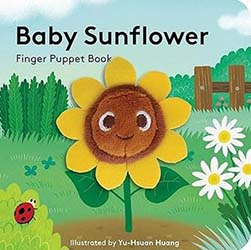
BABY SUNFLOWER: Finger-Puppet Book
written/illus. by Yu-Hsuan Huang, (Chronicle Books, Mar, 2024, 7.99, ISBN 798-1-7972-2791-7), 12p, Ages Baby – 3
Babies and toddlers will love touching, feeling, and loving Baby Sunflower as he realizes that his pot is too small, plants his roots in more soil, follows the sun across the sky, meets friends in the garden, dances and sways to the wind, and grows and blooms just like little ones enjoying this cute tale.
Themes:
Adventure, Nature, Series
Other Finger Puppet Books in the Series: Baby Alligator, Baby Bear, Baby Bunny, Baby Cactus, Baby Chipmunk, Baby Duck, Baby Elephant, Baby Fish, Baby Fox, Baby Giraffe, Baby Hedgehog, Baby Hippo, Baby Kitten, Baby Koala, Baby Llama, Baby Mushroom, Baby Narwhal, Baby Octopus, Baby Orca, Baby Otter, Baby Piglet, Baby Puppy, Baby Raccoon, Baby T. Rex, Baby Tiger, Baby Unicorn, Baby Yeti, Baby Red Panda
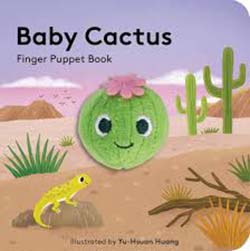
BABY CACTUS: Finger-Puppet Book
written/illus. by Yu-Hsuan Huang, (Chronicle Books, Mar, 2024, 7.99, ISBN 798-1-7972-2790-0), 12p, Ages Baby – 3
Babies and toddlers will love touching, feeling, and enjoying Baby Mushroom as she wakes up in the desert sun, realizes she has grown a beautiful pink flower hat and prickly spines, loves to drink the rain water, and keeps growing and growing, just like little ones enjoying this cute tale.
Themes:
Adventure, Nature, Series
Other Finger Puppet Books in the Series:
Baby Alligator, Baby Bear, Baby Bunny, Baby Chipmunk, Baby Duck, Baby Elephant, Baby Fish, Baby Fox, Baby Giraffe, Baby Hedgehog, Baby Hippo, Baby Kitten, Baby Koala, Baby Llama, Baby Mushroom, Baby Narwhal, Baby Octopus, Baby Orca, Baby Otter, Baby Piglet, Baby Puppy, Baby Raccoon, Baby Red Panda, Baby Sunflower, Baby Tiger, Baby Unicorn
|
| |
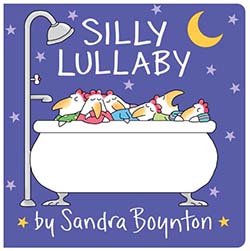
SILLY LULLABY
written/illus. by Sandra Boynton, (Boynton Bookworks / Simon & Schuster, 2019, $11,99, ISBN 978-1-6659-5461-7),16p, Ages 2+.
“Your pajamas are on. / There’s a duck on your head. / I think that this means / you are ready for bed.” Thus begins a hilarious tale of a little bear climbing into dad’s lap and listening to a silly bedtime song with lyrics of zoodles, fibblety-fitsy foos, chickens in a bathtub, closets full of sheep, and sneakers in a freezer.
The little fellow finally settles down to an owl whispering “Moo” as dad tells his Little Zoodle good night and, Zoodle replies, “Good night Fitsy Foo.” Delightful nonsense and silly songs always make for a great read-aloud at bedtime. Kids will love the silly images and sound effects, while adults may want to sing along with the musical score.
Themes:
Animals, Bedtime, Family, Humor & Nonsense, Series
|
| |
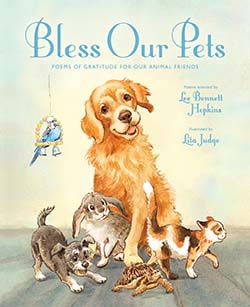
BLESS OUR PETS:
Poems of Gratitude for Our Animal Friends
selected by Lee Bennett Hopkins, illus. by Lita Judge, (Eerdmans Books for Young Readers, April 2024, $17.66, ISBN 978-0-8028-5546-6), 40p, Ages 5-8
Fourteen charming poems pay tribute to the love of pet companions who bring unending love, happiness, and fun into their owners’ lives. This unforgettable and delightful anthology features a tiny “Kitten” by Ann Whitford Paul, an adorable “Puppy” by Rebecca Kai Dotlich, a dancing “Goldfish” by Linda Trott Dickman, “A Prayer for My Gerbil” by Eric Ode, a “Prayer for a Parakeet” by Ralph Fletcher, “Hamster Hoping” by Sarah Grace Tuttle, a “Lop-Eared Rabbit” by Joan Bransfield Graham, a pony in “Dreaming of Savannah” by Kristine O’Connell George, “A Letter to My Guinea Pig” by Darren Sardelli, “Box Turtle” by B. J. Lee, “Pet Snake? By Charles Ghigna, “Mouse Dreams” by Lois Lowry, “Old Calico” by Prince Redcloud, as well as ”My Old Dog” by Lee Bennett Hopkins. This wonderful anthology, including the marvelous illustrations of the talented Lita Judge, is a worthy addition to any child’s library.
Themes:
Animals, Anthologies, Bedtime, Friendship,
Humor, Pets, Rhythm & Rhyme
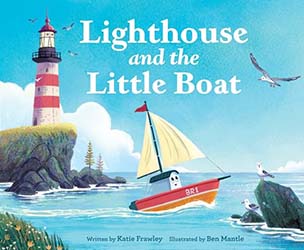
THE LIGHTHOUSE AND THE LITTLE BOAT
written by Katie Frawley, illus. by Ben Mantle, (Quill Tree Books, $19,99, May 2024, ISBN 978—0-06-311423-4), 32p, Ages 4-8
Once upon a time there was a proud and strong lighthouse who guided ships safely to her harbor, and they trusted her for protection. One summer morning a small boat, Brightness, appears in the harbor. She appreciates Lighthouse’s protection, until the call of the tide beckons. The lighthouse cautions her about dangerous waters, but one day Brightness sails away to see the world. Dismayed, Lighthouse realizes that Brightness “didn’t even say goodbye.”
As a storm blows in and summer ends, Lighthouse worries over the little sailboat’s safety and calls to the wind for help, but no answer came. As the seasons change, Lighthouse waits and worries, especially after an epic winter storm. Eventually Brightness sails in, battered and broken, but Lighthouse floods the waves with her light, calling “Come to me!” and guides the little boat home safely, knowing that she will desire adventure again.
Readers will love this beautiful tale paralleling the relationship between loving parents and the steps children take for independence. Adults will love the author’s dedication.
Themes:
Adventure, Friendship, Oceans, Values
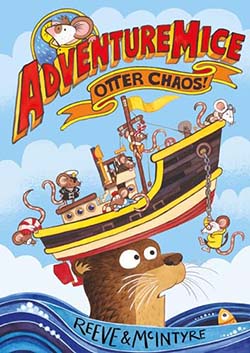
ADVENTURE MICE: OTTER CHAOS
written by Philip Reeve, Illus. by Sarah McIntyre, (Kane Miller EDC Publishing, $7.99, 2024, ISBN 978-1-68464-853-5), ,128p, Ages 5-7
Pedro is an adventurous mouse, but his father always said, “Adventures are scary, dangerous, and uncomfortable.” Hearing stories about the legendary Mouse Islands, fearless mice, beautiful mermice, and wicked pirate rats, Pedro packs his suitcase and sets off in search of Mouse Island. Waylaid by a giant wave, the little mouse is swept out to sea, only to be rescued by a mouse-sized seaplane and taken to Mouse Islands.
There he joins a band of mice called the Adventuremice, whose jobs are to keep the residents of Mouse Islands safe. When a dangerous otter, Morlake, appears, can Pedro prove himself or will the adventures be too much for him? Find out in this tale of courage, humor, kindness, and cooperation in the fast-based action world of Adventuremice. Kids will love the Daring Dormouse ship, Fledermaus’ plane, Juniper’s submarine, Millie’s helicopter, the marvelous illustrations of the Mousebase, Mouse Islands, and the drawing guide.
Themes:
Adventure, Animals, Chapter Books, Fantasy, Friendship, Heroes, Humor
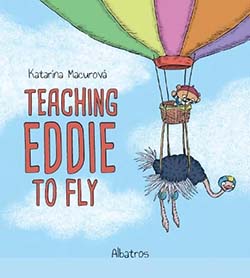
TEACHING EDDIE TO FLY
written/illus. by Katarína Macurová, translated by Andrew Oakland, (Albatros Media. 2024, $14.95, ISBN 978-80-00-07077-3. 32p, Ages 4-8
When Arthur, a small bear, realizes that his ostrich friend, Eddie, cannot fly, he is determined to teach him. Eddie gives him lectures on the basics of flying, shows him aeronautical concepts on a chalkboard, and tells him to flap his wings. Nothing works, even when Eddie is attached to a hot air balloon, jumps off a diving board, or dangles from a parachute. They ask various animals how to fly, but the penguin replies, “What’s flying”, a kiwi thinks of a fly to eat, and a parrot simply says, “Fly, fly, fly, fly, fly, fly.”
When Arthur becomes tired walking home, Eddie offers to carry him. As Eddie begins to walk faster and faster, he realizes that “he’s running as fast as other birds fly.” Finally understanding that Eddie doesn’t need to fly, discover what Arthur decides to teach Eddie next. Kids will love the charming and humorous illustrations, the endearing support of friends, and the hilarious results of “Teaching Eddie to Fly.”
Themes:
Adventure, Animals, Friendship, Heroes, Humor
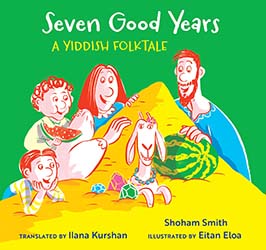
SEVEN GOOD YEARS: A Yiddish Folktale
translated by Llana Kurshan, illus. by Eitan Eloa, (Kalanoit Books, $19.99. 2023. ISBN 978-8-9863965-2-1). 32p. Ages 5-8
“Tuvia was very poor. He didn’t even have a belt to hold up his pants, so he used an old rope instead. He lived in a ramshackle hut with Sorka, his wife, and their children, and he worked in the marketplace as a porter, carrying heavy loads.” When his work stops and there is no money for food, he prays “Please, please, if only I could return home with something for my family.” Suddenly a man dressed in green tells him that he will enjoy seven years of good fortune. Upon returning home, Tuvia discovers his family surrounded by a pile of gold.
At the end of the seventh year the Green man returns only to find that Tuvia did not change his lifestyle, but only used the gold for what was needed to live on. After returning the gold to the Green man, they are rewarded for their goodness and experience a surprising future. Readers will enjoy this clever Yiddish folktale based on ancient rabbis’ teachings: “Who is wealthy? One who is content with what they have.”
Themes:
Adventure, Family, Fold Literature, Heroes,
Values
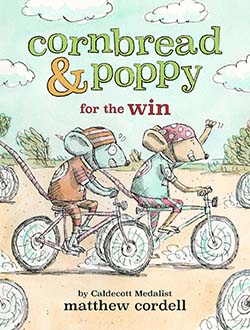
CORNBREAD AND POPPY FOR THE WIN
written/illus. by Matthew Cordell, (Little Brown and Company, $6.99, April 2024, ISBN 978-0-316-50877-3), 80p, Ages 6-9
“The annual Small Rodents Competitive Cycling Championship Classic—the SRCCCC—was tomorrow. Cornbread and Poppy had been training for months.” Despite being best friends, they are extremely opposite. Poppy is competitive but Cornbread is not. Poppy is determined to win, but Cornbread just enjoys their time together. Poppy loves racing pants, but Cornbread prefers regular pants, but he reluctantly accepts Poppy’s gift of new pants.
As the day of the race dawns, both racers are more than ready to win, as are the other rodents, especially Pound Cake, who holds the record for winning. Determined to win this time, Poppy and Cornbread have a master plan, however, sometimes things turn out differently than planned, especially when Cornbread’s new pants begin to rip. Kids will enjoy the mixture of adventure, friendship, humor, and the heart of true heroes.
Themes:
Adventure, Animals, Friendship, Heroes, Humor, Series, Values
Other Books in the Series:
Cornbread & Poppy | Cornbread & Poppy at the Carnival | Cornbread & Poppy at the Museum
|
| |

SHERLOCK BONES AND THE CASE OF THE CROWN JEWELS:
A Puzzle Adventure
written by Tim Collins, Ilus, by John Bigwood, (Buster Books, $7.98, 2023, ISBN 9778-1-78055-750-2), 192p, Ages 7-10
This first adventure in the Sherlock Bones series finds dog detective Sherlock and his trusty sidekick Dr. Catson called to Buckingham Palace to solve a mystery surrounding the theft of the Queen’s jewels. They have their hands full with keeping the crazy police pups under control, solving other crimes committed at the same time, dealing with a Sewer Beast, and determining if there is one mastermind or several separate crimes.
Humor abounds in this light-hearted mystery with over 30 mazes, number puzzles, searches, and questions throughout the seven chapters with answers in the end papers.
Themes:
Adventure, Animals, Heroes, Humor, Mysteries,
Series
Other books in the Series: Sherlock Bones and the Curse of the Pharaoh’s Mask | Sherlock Bones and the Horror of the Haunted Castle | Sherlock Bones and the Mystery of the Vanishing Magician
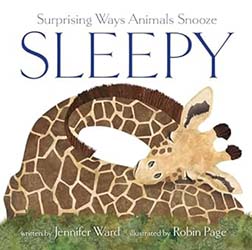
SLEEPY: Surprising Ways Animals Snooze
written by Jennifer Ward, illus. by Robin Page, (Beach Lane Books, $18.99, July 2024, ISBN 978-1-6659-3510-4), 32p, Ages 7-10
“All animals sleep. But not all animals sleep in the same way.” Thus begins a cumulative and rhythmic tale of sixteen animals and their quaint sleeping habits. Readers will discover that dolphins are able to both swim and sleep near the surface of the ocean, called “unihemispheric slow-wave sleep”. Bats sleep upside down for 20 hours at a time, snakes sleep with their eyes open, and koalas are the sleepiest animals in the kingdom, sleeping around 22 hours a day.
Other animals featured include hummingbirds, sea otters, grizzly bears, humpback whales, frogs, giraffes, African elephants, sloths, desert tortoises, nurse sharks, great frigatebirds, and orangutans. Each page contains a clever animal poem (“Snake: you lie still with open eyes, | spectacles worn as a guise. | Are you sleeping or awake? | Hard to tell, you tricky snake!”), and short paragraphs describing the animals’ sleeping habits. A concluding bedtime poem surrounds a sleeping child.
Endpapers contain information on “Types of Sleep in This Book” (brumation, hibernation, etc.), “Other Words to Wonder About” (crepuscular, diurnal), and “Average Snooze Time for Animals in the Wild Per Day”. Readers and listeners will thoroughly enjoy this cozy, informative, bedtime book for years to come.
Themes:
Animals, Bedtime, Concept, Nature, Nonfiction, Rhythm & Rhyme
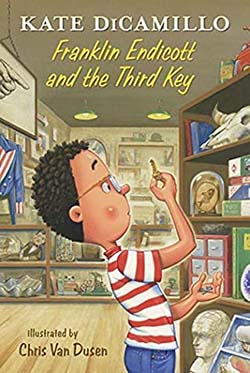
FRANKLIN ENDICOTT AND THE THIRD KEY:
Tales from Deckawoo Drive #6
written by Kate DiCamillo, illus. by Chris Van Dusen, (Candlewick Press, $6.99, June 2024), 112p, Ages 6-9
This 6th installment of the Deckawoo Drive books finds worrier, Franklin Endicott, concerned about many things, from lions, black holes, armadillos, and alligators to submarines vampire bats, and goats. He keeps a notebook and lists the worries in alphabetical order and cross-references them. When Franklin hides his notebook under his bed, the nightmares begin.
Accompanying neighbor Eugenia Lincoln on her errand to make a duplicate key at Buddy Lamps Used Goods, Eddie discovers that an extra key is included with the original key and its copy, which adds to his worries. Fortunately, his friends and neighbors encourage him with help from short stories by O. Henry, hot chocolate, and a friendly pig named Mercy Watson. Kids will enjoy solutions to worry and the marvel of mysteries.
Themes:
Animals, Chapter Books, Friendship, Humor,
Mysteries, Series
Other Books in the Deckawoo Series: Leroy Ninker Saddles Up | Francine Poulet Meets the Ghost Raccoon |
Where Are You Going, Baby Lincoln? | Eugenia Lincoln and the Unexpected Package | Stella Endicott and the Anything-Is-Possible Poem
|
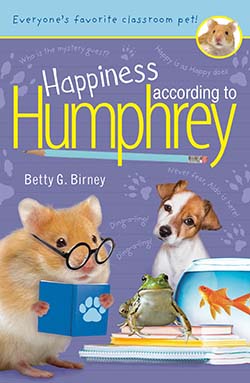
HAPPINESS ACCORDING TO HUMPHREY
written by Betty G. Birney, (G. P. Putnam’s Sons, $ 17.99, May 2024. ISBN 978-0-593-69761-0), 144p, Ages 8-11
To celebrate the Humphrey series’ 20th anniversary, the little industrious classroom hamster looks forward to a special guest coming to Room 26. The guest turns out to be a big, gentle dog (with sharp teeth) named Happy, who comes to help the class with their reading. They love Happy, and the students relate stories of other dogs, including a beloved pet who is missing. Great at helping the children solve problems and mysteries, Humprey jumps right in to help find the missing pet, but he is stymied when the other class pet, Og the frog, becomes mysteriously ill.
At the end of each chapter, Humphrey expresses his thoughts about happiness based on his perception of the classroom. “HUMPREY’S HINTS FOR A HAPPY LIFE: While it’s a great idea to be friendly to others it’s okay to be careful around creatures with large, sharp teeth.”
Readers will enjoy the lessons of working together, sharing feelings with others, solving mysteries, plus the anonymous messages Humphrey leaves for others to find, and his hidden journal inside his cage.
Themes:
Animals, Friendship, Humor, Mysteries, Pets,
Series
Other Books in the Series:
The World According to Humphrey, | Friendship According to Humphrey, | Trouble According to Humphrey, | Surprises According to Humphrey, | Adventure According to Humphrey, | Summer According to Humphrey, | School Days According to Humphrey, | Mysteries According to Humphrey, | Winter According to Humphrey, | Secrets According to Humphrey, | Imagination According to Humphrey, | Spring According to Humphrey
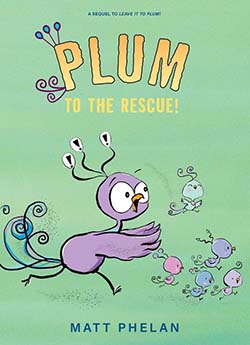
PLUM TO THE RESCUE
written/illus. by Matt Phelan, (Greenwillow Books, May 2024, $18.99, ISBN 978-0-06-329629-9), 128p, Ages 8-12
It’s springtime at the Athensville Zoo, where the “peppy purple peacock” Plum is given the responsible job of watching five exuberant and energetic, peachicks. Plum’s supervisory job takes a downturn when the smallest peachick “Pip” is kidnapped by the Bickle Brats, two badly behaved children who often get kicked out of the zoo.
Plum begins a rescue effort and enlists the help of the zoo’s “ningbing” Itch, friendly cats Jeremy and Bongo, and sewer opossums to locate the Bickle home. Once there, the rescue effort turns problematic as the Bickle yard is surrounded by a high chain-link fence, protected by a German shepherd dog, and little Pip is locked up in the shed. Discover how the daring rescue mission changes from Pip to Plum in this humorous and kindhearted tale of hope, friendship, and love. This highly illustrated novel is also perfect for reluctant readers and animal lovers everywhere.
Themes:
Adventure, Animals, Chapter Books, Family,
Friendship, Heroes, Humor, Series
Other Books in the Series:
A Snow Day for Plum! | Trouble Finds Plum | Leave It to Plum
|
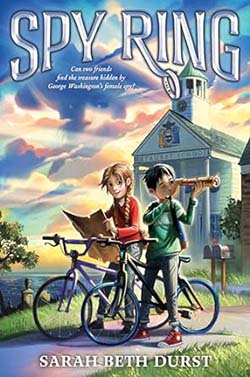
SPY RING
written by Sarah Beth Durst, (Clarion Books, May 2024, $18.99, ISBN 978-0-06-332345-2), 224p, Ages 10-13
What do two 11-year-olds from Setauket, Long Island, a 200-year-old spy ring, cryptic clues, codewords, secret signals, and George Washington’s Culper Spy Ring have in common? They all come together for a fascinating tale and scavenger hunt surrounding Anna Smith Strong and the Culper Spy Ring, operated under George Washington during the Revolutionary War in Setauket.
When Rachel eavesdrops on a family conversation, she discovers that an antique ring, passed down through her soon-to-be stepdad’s family, belonged to Anna “Nancy” Smith Strong, the only female member of George Washington’s famed Culper Spry Ring. After secretly grabbing the ring, removing the tarnish, and uncovering a coded message “Find Me,” Rachel and her best friend Joon begin a scavenger hunt for historical facts surrounding the Culper Spy Ring and Nancy Strong’s involvement. Their exploitations, intelligence, and persistence take them from a local cemetery to a historical society, a local church, and famous battle sites, in this clever tale that brings history to life.
The author’s note explains historical fact from fiction.
Themes:
Adventure, Families, Friendship, Heroes, Historical Fiction, Mysteries
|
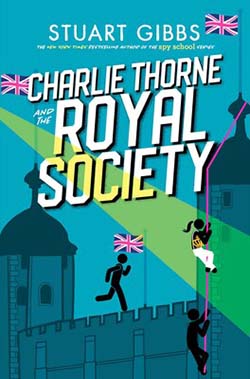
CHARLIE THRONE AND THE ROYAL SOCIETY #4
written by Stuart Gibbs, (Simon and Schuster Books for Young Readers, $17.99, April 2024, ISBN 978-1665934893), 416p, Ages 12-15
This fourth installment in the Charlie Thorne series finds thirteen-year-old Charlie and former CIA agents Danta Garcia and Milana Moon searching for Isaac Newton’s “Greatest Treasure”. Chasing clues across the rooftops of Cambridge University, scaling the Sydney Harbour Bridge, and evading a volcanic eruption in Hawaii, Charlie escapes kidnappers as she follows Newton’s trail of clues. To complicate matters, the CIA is hunting down Dante and Milana as rogue agents. Will Charlie discover Isaac Newton’s secret, and if so, what can she do about it?
Readers will enjoy the Prologue surrounding the life of Isaac Newton, his escape from enemies, and hiding his secret discovery. “What he had discovered was incredible, with the power to change the world forever, but humanity wasn’t ready for it yet.” This great adventure/mystery also contains interesting side information throughout the story on Issac Newton, James Cook, and the Royal Society, as well as various historical events and places.
Themes:
Adventure, Families, Heroes, Historical Fiction, Mysteries, Series
Other Books in the Series: Charlie Thorne and the Last Equation | Charlie Thorne and the Lost City | Charlie Thorne and the Curse of Cleopatra
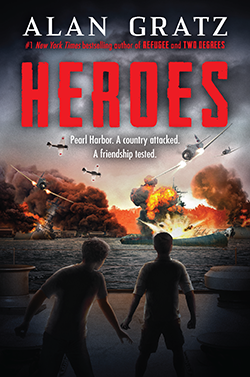
HEROES: A Novel of Pearl Harbor
written by Alan Gratz, comic art by Judit Tondora, map by Jim McMahon, (Scholastic, Inc, $18.99, Feb. 2024, ISBN 978-1-338-73607-6), 272p, Ages 12-15
On the day that will live in infamy, December 7, 1941, 13-year-old best friends, Frank McCoy and Stanley Summers, sons of Navy fighter pilots stationed on the Pearl Harbor Naval base, enjoy soaking up the sun and sharing a love of writing and drawing their own comic books of heroes with superpowers.
While touring the battleship Utah, their lives change forever when Japanese planes appear and begin dropping bombs and underwater torpedoes on the Pearl Harbor battle ships. With explosions and danger everywhere, the boys abandon the sinking Utah, swim back to Ford Island, struggle to find safety, witness many horrors, and help bring injured sailors to safety. When Frank, a white American, realizes that Stanley, a Japanese American, is condemned by those who consider him the enemy, against all his fears, he begins to stand up for Stanley and fight back against the irrational prejudice.
This fascinating look at one of America’s most infamous times explores themes of prejudice, power, and what it truly means to be a hero. The epilogue contains Frank and Stanley’s 10-page comic strip published as adults, a map of Pearl Harbor, the author’s note on the history of America’s reluctance to join the war, Asian American in Comics, and The Legacy of Pearl Harbor.
Themes:
Adventure, Families, Friendship, Heroes,
Historical Fiction, Suspense, Values
Other Books in the Series: Ground Zero, Projekt 1065, Code of Honor
|
StoryKeepers
Summer Adventures from the Past
to Read, Share, and Treasure
Leave your busy life and pull up a chair, the Storykeepers will meet you there.
|
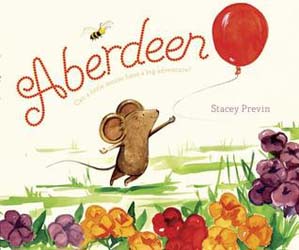
ABERDEEN
written/illus. by Stacey Previn, (Viking Children’s Books, 2016), 40p, Ages 3-6
A curious little mouse offers many excuses for making unwise choices. “Aberdeen didn’t mean to leave the yard. BUT a balloon floated by, so he followed it.” He didn’t mean to trample the neighbor’s flowers, or dig a hole under their fence, or let the balloon carry him away. As his mishaps continue, he falls into the mud, splashes in a puddle, and confronts a dangerous owl. When Mama comes to the rescue, Aberdeen apologizes with “I didn’t mean to make you worry.” Choices do have consequences.
Themes:
Adventure, Animals, Values
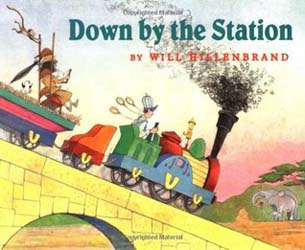
DOWN BY THE STATION
written/illus. by Will Hillenbrand, (Houghton Mifflin Harcourt, 1999, ISBN 978-0152018047), 40p, Ages 3-7
“Down by the station early in the morning” an industrious train engineer pulls into the Zebra Station and picks up a safari-clad traveler with her own toy trains (puffer-bellies). The busy train chugs merrily along picking up various baby animals, each dropped off by their mom and dad, on the way to the Children’s Zoo before opening hours.
At the first stop a baby elephant calf is picked up, then flamingo chick, panda cub, tiger cub, seal pup, and a joey kangaroo. As each baby animal joins the train, their own sounds are added to the cumulative refrain. “See the engine driver / pull his little lever… Puff, puff, / Toot, toot, / Thrump, thrump, / Peep, peep, / Grump, grump, / Mew, mew, / Flip, flop / Bump, bump, / Off we go!” Along the way danger occurs when the seal pup and baby penguin jump off the train into a pond full of crocodiles. Children can search for a runaway red balloon on each page and watch a yellow school bus wind its way to the zoo carrying children to play with the animals. Children will enjoy the music on the last page in this charming and clever romp to the zoo.
Themes:
Adventure, Animals, Humor, Machines, Rhythm & Rhyme
|
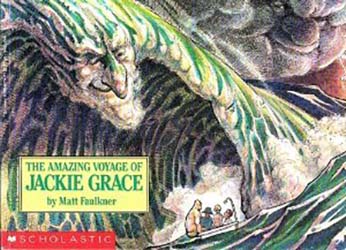
THE AMAZING VOYAGE OF JACKIE GRACE
written/illus. by Matt Faulkner, (Scholastic Inc., 1987), 40p, Ages 5-8
Jackie is a boy with a lively imagination and enjoys nothing more than a good bath. On this bathtub voyage, Jackie is joined by a captain and two sailors, who are searching for their ship that was stolen by pirates. Overcoming high seas and determined pirates, Jackie rescues the ship and defeats the pirates, just before his mom calls.
Themes:
Adventure, Fantasy, Heroes
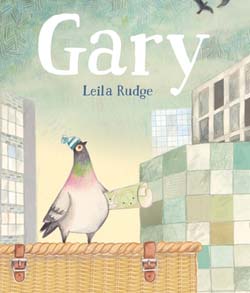
GARY
written/illus. by Leila Rudge, (Candlewick Press, $16.99, Nov. 2016, ISBN 978-0-7636-8954-4), 32p, Ages 4-8
“Most of the time, Gary was just like the other racing pigeons. He ate the same seeds. Slept in the same loft. And dreamed of adventure.” However, Gary cannot fly, so on racing days he stays behind and organizes his scrapbook of travel mementos from the other pigeons. One day Gary’s life radically changes when he and his beloved scrapbook accidentally fall into the travel basket, and he awakes in the big city, alone.
Find out how Gary plots his way back home, uses his beloved scrapbook as a guide, discovers an ingenious way of traveling, and returns with souvenirs of his own. Even the racing pigeons love Gary’s clever way of traveling. With lessons of perseverance, resiliency, and innovation, strength can be found in the most unlikely circumstances.
Themes:
Adventure, Animals, Humor
|
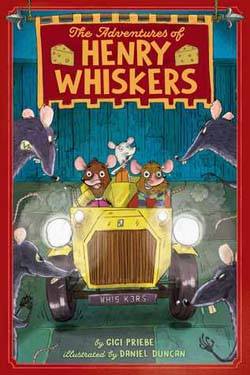
THE ADVENTURES OF HENRY WHISKERS
written by Gigi Priebe, illus. by Daniel Duncan, (Aladdin Books, $16.99, Jan. 2017, ISBN 978-1-4814-6575-5), 160p, Ages: 7-10
At Windsor Castle there resides the magnificent Queen Mary’s Dollhouse, built in the 1920’s, with four floors, 40 rooms, 2 working elevators, hot and cold running water, and electricity. Never meant for dolls or children to play with, it is only used for exhibition. However, it has been home for 25 generations to the Whisker family, who live in the empty storage drawers built into the base.
Exploring is great fun for Henry Whisker and his cousin Jeremy, but they are always careful to avoid detection by the museum staff and Titus, the resident cat. When Henry’s little sister disappears, they begin a grand adventure to rescue Isabel. Avoiding the cat, Henry and Jeremy drive a miniature car, escape from the dangerous Rat Alley, rescue a baby rat, and make unexpected friends. Along the way they manage to avoid humans, who are cleaning the dollhouse for the Queen’s royal birthday banquet, which coincides with the Whiskers’ Annual Mouse Masquerade. Kids will love this brave, loyal, cheerful, and courageous hero in his first adventure.
Themes:
Adventure, Animals, Friendship, Heroes, Series
Other Books in the Series:
The Long Way Home
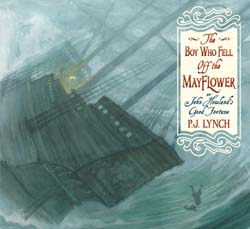
THE BOY WHO FELL OFF THE MAYFLOWER:
Or John Howland's Good Fortune
written/illus. by P. J. Lynch, (Candlewick Press, $17.99, Sept. 2015,), 64p, Ages 7-10
Based on historical facts, this memorable story surrounds a young indentured servant, John Howland, who sailed on the Mayflower with his master from 1620 London to the New World. The crossing was difficult especially during a storm when John was swept overboard. “Far up above, I saw the Mayflower's keel. I thought, That's my ship . . . She's taking me to America! A flash of lightning lit up a long rope trailing down from the ship. I pulled myself over toward it. My lungs were bursting now, but I caught hold of the rope and held on tight in the freezing water.” Once land was reached, the settlers faced more difficulties with the onset of winter, lack of food, sickness, and aggression toward the natives, which all contributed to the death of more than half of the original settlers.
With the arrival of Spring the community prospered with the friendship of Squanto, the organization of a new government, and John's decision to stay in America. Endpapers feature a Bibliography and Author's Note on John Howland's future. This dynamic depiction of one Pilgrim's adventure on the Mayflower and early experiences in America is one story not to be missed.
Themes:
Adventure, Historical Fiction
|
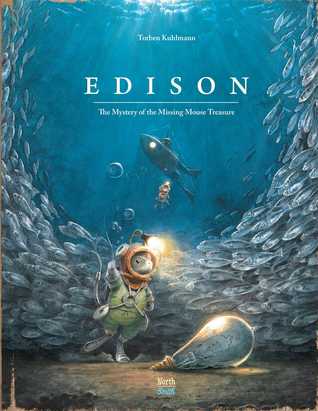
EDISON:
The Mystery of the Missing Mouse Treasure
written/illus. by Torben Kuhlmann, translated by David Henry Wilson, (North South Books, $19.95, Oct. 2018, ISBN 978-0-7358-4322-6), 112p, Ages 8-11
The adventures from Torben Kuhlmann’s Lindbergh: The Tale of a Flying Mouse (2014) and Armstrong: The Adventurous Journey of a Mouse to the Moon (2016) continue in the newest tale of underwater exploration. A young mouse brings an old letter to a professor at the University of Mice and explains that, “Many years ago, one of my ancestors sailed across the Atlantic. And he took a large treasure with him.”
Thus Pete and the Professor begin a search for clues in newspaper clippings and discover that the transatlantic liner, carrying Pete’s ancestor, sank. It doesn’t take long to locate the wreck. Now begins the arduous and sometimes dangerous task of experimenting with trial and error to build a submarine. The day finally arrives when they and their submarine stowaway in a shipping container on a cargo ship and make the journey across the Atlantic to dive for the sunken ship and treasure.
Their amazing underwater adventure becomes unforgettable as they discover secrets beyond their wildest imaginations. Could it be that young Pete’s ancestor survived the sinking and went on to help a famous human inventor? Kids will pour over the illustrations, especially antique-like drawings of the various underwater inventions.
Themes:
Adventure, Animals, Fantasy, Heroes,
Inventions, Series
Other Books in Series: Lindbergh: The Tale of a Flying Mouse | Armstrong: The Adventurous Journey of a Mouse to the Moon | Einstein: The Fantastic Journey of a Mouse Through Space and Time
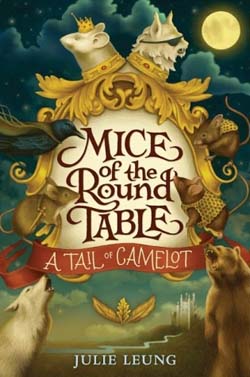
MICE OF THE ROUND TABLE:
A Tail of Camelot Bk#
written by Julie Leung, illus. by Lindsey Carr, (HarperCollins, Oct. 2016, ISBN 978-0-06-240399-5), 304p, Ages 9-12
Caleb Christopher, a young mouse page in King Arthur’s castle, dreams of becoming a brave knight of the Round Table, preserving his family name, and following in the “pawsteps” of his famous father and grandfather. Before he can participate in the Harvest Tournament, a competition leading to knighthood, his grandfather is murdered, and the Camelot mice suspect the animals from the Darkling Woods. Caleb believes an old enemy plans an invasion of Camelot, and he sets out to unite the rodent population, the forest animals, and the humans (two-leggers), after discovering that the Sword in the Stone, which appears at Camelot’s darkest times, has returned. Along the way he befriends 11-year-old Galahad, the son of Sir Lancelot, and the two heroes face parallel battles against the invading Saxon weasels and soldiers. In this first action-packed adventure of the Mice of the Round Table series, readers will root for this small hero in his quest to save the legendary Camelot and the Knights of the Round Table.
Themes:
Adventure, Fantasy, Heroes, Series
|
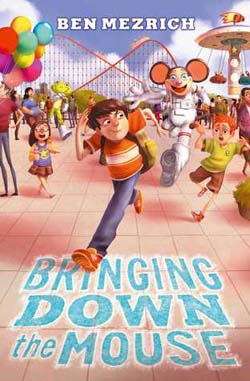
BRINGING DOWN THE MOUSE #1
(A Charlie Numbers Adventure)
written by Ben Mezrich, (Simon & Schuster Books for Young Readers, $16.99, July 2014, ISBN
978-1-4424-9626-2), 336p, Ages 9-12
Exceptionally good at math equations, sixth-grader Charlie Lewis hangs out with kids known as the Geek Squad, earning the nickname of Numbers. Charlie is rescued from a school bully by a seventh grader, who invites him to join a secret gang, the Carnival Killers.
This group of middle school kids is led by a college student, who needs Charlie’s math abilities to defeat the rigged carnival midway games, win lifetime tickets for the group to Incredo Land in Florida, and $50,000 for a teacher’s aid program.
When Charlie realizes the leader’s illegal purposes, he decides to change the outcome. Excitement, adventure, and risk-taking will keep readers guessing the conclusion.
Themes:
Adventure, Friendship, Mysteries, Series
Others in the Series:
Charlie Numbers and the Man in the Moon #2 | Charlie Numbers and the Wooly Mammoth #3
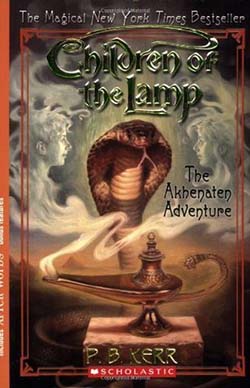
CHILDREN OF THE LAMP:
The Akhenaten Adventure
written by P. B. Kerr, (Orchard Books, 2004), 368p, Ages 10+
Twelve-year-old twins John and Philippa Gaunt live an uneventful life in New York City, until they have their wisdom teeth out, and discover a love smoke and heat and an ability to grant wishes. When they visit their eccentric uncle Nimrod in London, he informs them that they are descended from Djinn.
As Nimrod begins their training, they travel to Egypt in search of the pharaoh, Akhenaten and his 70 lost Djinn. Legend states that whoever finds the tomb will have the ability to command them. With the help of an Irish speaking Djinn, a human butler, and an Egyptian chauffeur, the children manage to save the world from evil.
Themes:
Adventure, Families, Fantasy, Folk Literature, Heroes, Series
Other Books In the Series:
The Blue Djinn of Babylon #2 | The Cobra King of Kathmandu #3 | Day of the Djinn Warriors #4 | The Eye of the Forest #5 | The Five Fakirs of Faizabad #6 | The Grave Robbers of Genghis
|
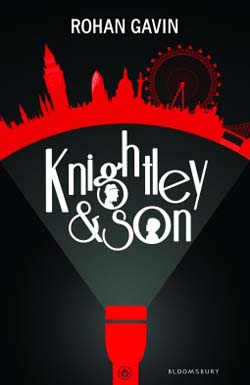
KNIGHTLEY & SON
written by Gavin Rohan, (Bloomsbury, 2014), 272p, Ages 12-15
Alan Knightley, a brilliant, dedicated, but obsessive detective suddenly awakens from a four-year coma ready to take on the Combination, an ancient criminal organization responsible for his coma and all unexplained crime in the world. Escaping the hospital, Alan seeks out his 13-year-old son, Darkus, who holds the key to his stolen records. With the help of Darkus’ deductive and observation skills, they unravel the mystery behind a self-help mystical book, THE CODE, tied to spontaneous criminal activity.
When Alan is kidnapped, Darkus continues the investigation, narrowly avoiding death at the hands of his stepfather, who has been hypnotized by THE CODE to kill him. Conspiracy theories, high speed car chases, irrational criminal behavior, secret WW II underground railway stations, and blended family dynamics, make this Sherlock Holmes-like read a great page-turner for the start of a new father-son detective series.
Themes:
Adventure, Heroes, Mystery, Suspense, Series
Other Books in the Series: Knightley & Son: K-9 | Knightley & Son: 3 of a Kind
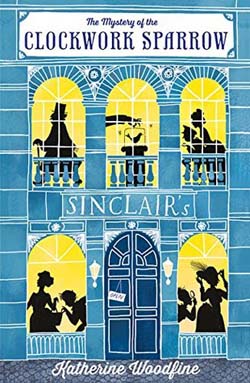
THE MYSTERY OF THE CLOCKWORK SPARROW
(The Sinclair Mysteries)
written by Katherine Woodfine, illus. by Julia Sardà, (Kane Miller Books, 2016), 352p, Ages 14+
“NEW YORK TYCOON TO TAKE LONDON BY STORM! New York millionaire Mr. Edward Sinclair is set to throw open the doors of London’s largest department store this week. The new Piccadilly store, which has been a year in construction, stands an impressive eight story’s high, with six acres of floor space, nine state-of-the-art lifts, and over one hundred different departments.”
During the Edwardian era of England, fourteen-year-old Sophie Taylor, orphaned after her father’s death and considered too old for an orphanage and old enough to support herself, is hired by Sinclair’s as a shopgirl to work in the Millinery Dept. Sophie is impressed with Mr. Sinclair’s special exhibition of jewels, including the Clockwork Sparrow, a musical box in the shape of a bird from the Russian Imperial Court. The Sparrow is considered priceless as it contains valuable gems with a unique ability to play a different tune whenever wound.
When a burglary occurs and the Sparrow is taken, Sophie is fired due to accusations by the store manager. With the help of new friends, Billy Parker, an apprentice porter and mystery-lover, Lilian Rose, a friendly store model and aspiring actress, and Joe, a homeless boy, who was involved with the crime lord known as the Baron, they band together to solve the mystery. Readers will enjoy the intrepid heroes as they solve messages coded in ciphers, uncover police corruption, discover explosive devices, and devour iced buns, while attempting to bring the villainous Baron to justice.
Themes:
Adventure, Friendship, Heroes, Mysteries,
Series
Others in the Series:
The Mystery of the Jeweled Moth #2 | The Mystery of the Painted Dragon #3 | The Mystery of the Midnight Peacock #4
|
|
Over the years, we have researched thousands of children's books, and can recommend some of the best in outstanding children's literature for parents to read aloud and children to read.
Our recommendations must meet certain criteria: fun, creative and imaginative stories, delightful illustrations, and excellent for age appropriate listening and reading. We hope that you enjoyed our recommendations. If you desire further information some of the best in children's literature, please visit our website, www.tchliteracy.com.
CONTACT US:
The Children's Hour
6497 Bellcross Trl
Whitsett, NC 27377
Email: info@tchliteracy.com |
|
|
|
|
|
|